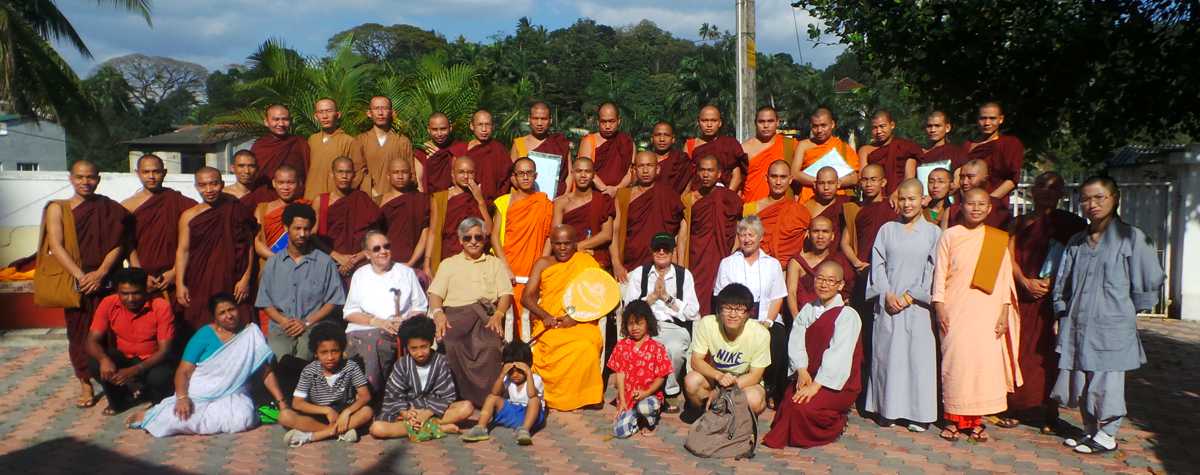 |
|||
|
Click the photo to see all the group photos of the Fifth Kandy Intensive Buddhist English Course
|
|||
Packed with Loving-kindness, February 14, 2014
Wow! We can breathe again. The Fifth Kandy Intensive Buddhist English Course is finished. Even now, it's hard to believe how successful it was, how smoothly everything went, and how happy everybody was. This was the longest intensive we've had in Sri Lanka, and it was brilliant. Much credit to Ven. Upali, the abbot of Asgiri Gedige Raja Maha Vihara, for allowing us the use of their classrooms again, to the Burmese Rest for housing the Burmese monk students, to Ven. Vilasagga for his cheerful and tireless organizing, to all the volunteer teachers for their generosity and enthusiasm, and to Lily and her team for turning out savory and nutritious lunch packets.
 |
|
| In this report, you can view almost every image larger by clicking on it. | |
Our teachers came from far and near. Daniel arrived first, from Nepal. Linda flew in from frosty Illinois, while Che (and his family) came from Beijing on Chinese New Year vacation. Lal came up from Colombo. Ven. Upatissa came from Ja Ela, Lalitha commuted from Peradeniya, and Mike, like us, is a Kandy resident.
We often say that we don't teach anymore. Rather, we try to create an atmosphere in which learning can happen. In our program of English for special purposes, namely, Buddhist English, this is particularly true. We are learners of the Dhamma, and our students are the "teachers." In our classes, the roles of teacher and student are constantly shifting. Given the serendipitous circumstance that the monastics are from different cultures and traditions, the best description of what happens is that we become good friends (kalaniya mitta), while learning from the classes, from extra-curricular activities, and from each other.
The new house certainly proved its worth. There is enough space to accommodate more than 40 monks for either a dana or a movie. During the first three weeks, Lily, her family, Soma and her husband, and Padma occupied both the small room and the guest room downstairs, so Linda settled into the library (with Nezumi as a regular roommate and Dushy for one night). Lal was quite comfortable for one week on a trundle bed in the living room. For the last week, Soma and her husband had to return to Colombo to attend to family matters, so Raja and Shehan moved to the small room, Lily, Padma, and, Surangi shifted into the ironing room in the back, and Che, his wife, and their five children stayed in the guest room. Noone was cramped.
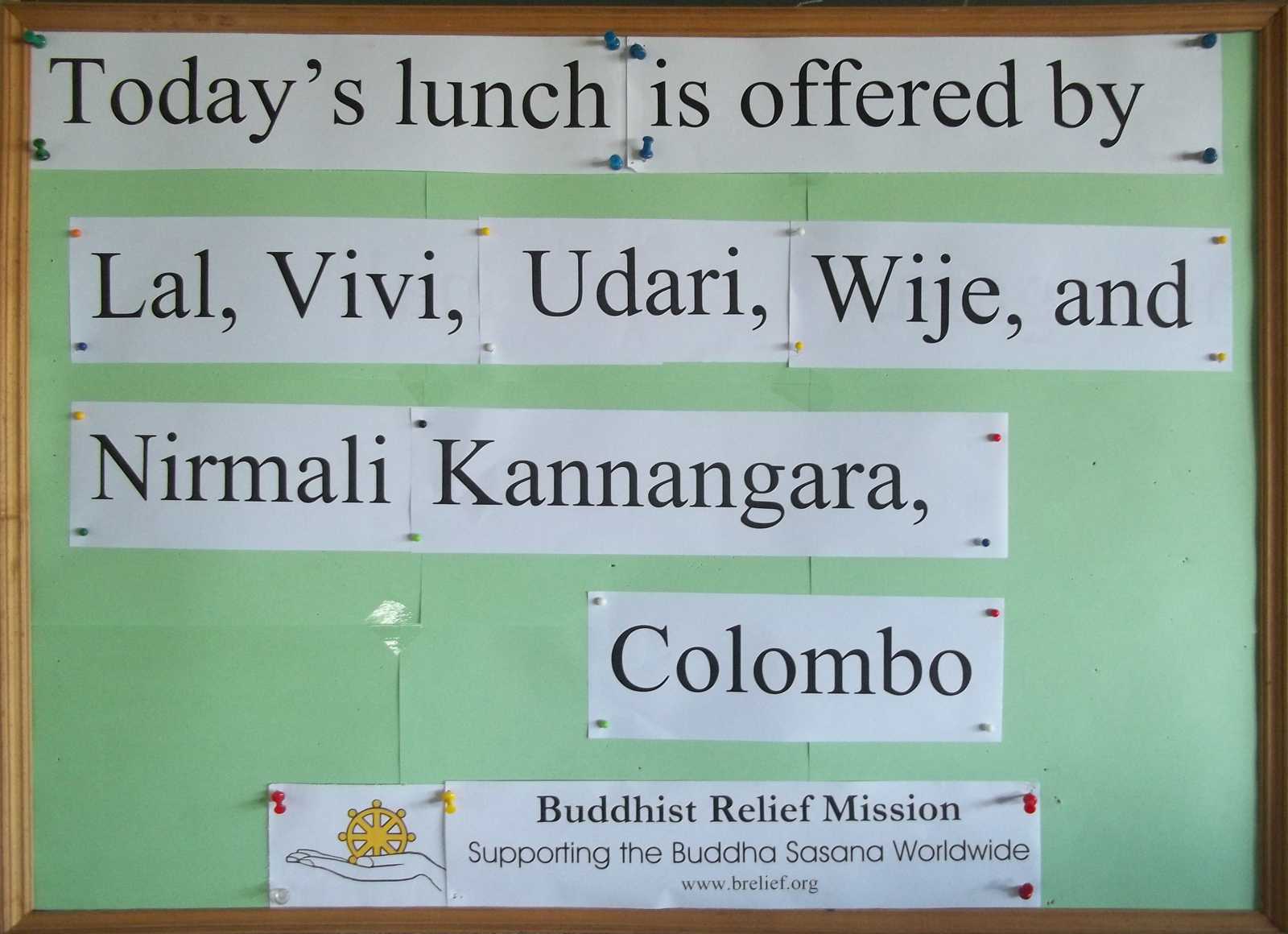 |
|
|
Click to see all the donors names on the daily boards
|
|
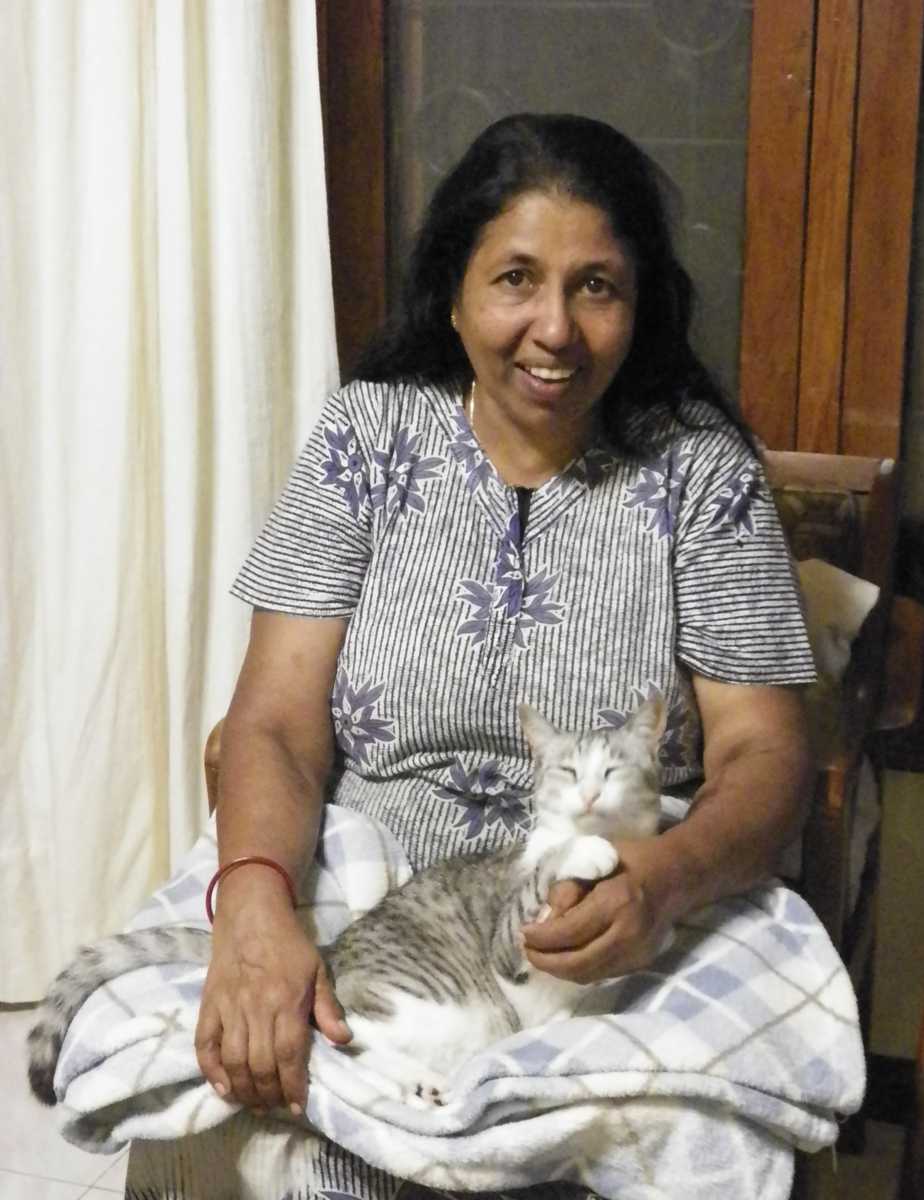 Fortunately, we were able to secure the food storage room with a heavy door, for, several times, a troop of monkeys came to raid the mango tree growing on the hillside in the back. Usually, they just picked the green mangoes, took one bite of each, and threw them down to crash on the metal roof of the back kitchen. What a racket! They were attracted, however, to the great quantity of food, and, one day, Lily and Soma had to stand guard, spraying the big boss with the hose to keep him away. We lost only one small bunch of bananas. Whenever the monkeys came, poor Nezumi retreated to the depths of our clothes closet until the ruckus died down.
Fortunately, we were able to secure the food storage room with a heavy door, for, several times, a troop of monkeys came to raid the mango tree growing on the hillside in the back. Usually, they just picked the green mangoes, took one bite of each, and threw them down to crash on the metal roof of the back kitchen. What a racket! They were attracted, however, to the great quantity of food, and, one day, Lily and Soma had to stand guard, spraying the big boss with the hose to keep him away. We lost only one small bunch of bananas. Whenever the monkeys came, poor Nezumi retreated to the depths of our clothes closet until the ruckus died down.
Every evening, the cooks, under Lily's supervision, fried peanuts and cleaned and chopped vegetables. After a few hours of sleep, they got up in the wee hours of the morning to cook the curries and the huge pots of rice. Because all their work was done in the outside kitchen, no wafts of pungent chili or wood smoke nor noise disturbed the sleeping teachers within. After dawn, the cooks assembled the packets, placing the rice, curries, and chutney on a sheet of banana leaf, generously donated by a neighbor, for flavor.
We were awakened each morning by our alarm-clock bird, punctually at 6 AM. We've yet to see him, but we have recorded his call and hope that someone will identify him for us.
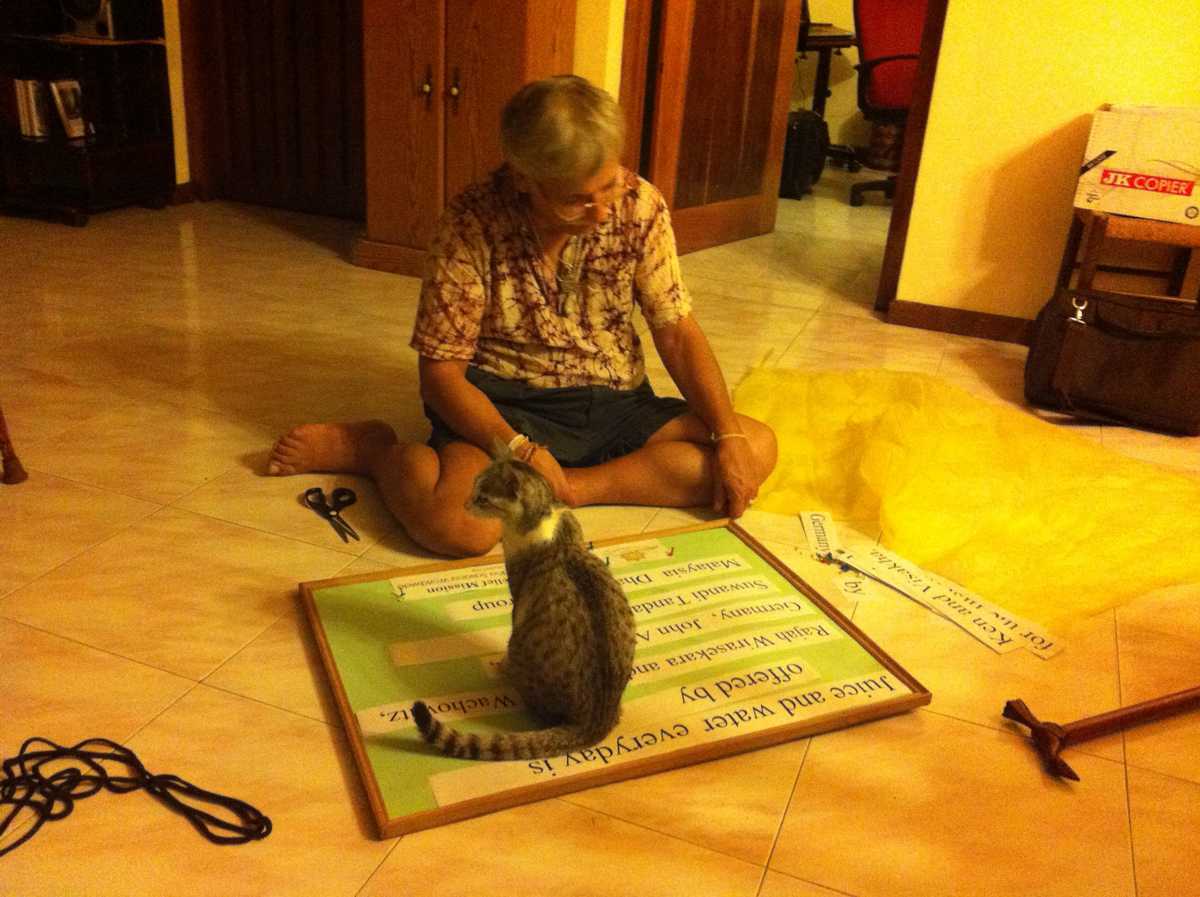
 Just before eight o'clock, Ashoka arrived to transport bottled water, juice, textbooks, notebooks, the daily dana board Ken had prepared, and the first-period teachers to the temple. Then he returned with the notebooks the students had written overnight. At ten, the other teachers went with boxes of neatly wrapped lunch packets to the temple.
Just before eight o'clock, Ashoka arrived to transport bottled water, juice, textbooks, notebooks, the daily dana board Ken had prepared, and the first-period teachers to the temple. Then he returned with the notebooks the students had written overnight. At ten, the other teachers went with boxes of neatly wrapped lunch packets to the temple.
At about eleven o'clock, Ken sounded his stentorian "gong" and led the students in a choral reading from "Wise Reflections." Then a selected monk read out the name of that day's donor and requested that all the students offer a blessing for the health and happiness of the donor, departed relatives, and all beings. In response, the monks and nuns chanted anumodana, sometimes in all three traditions--Burmese, Chinese, and Korean. After this, the laypeople distributed the lunch packets, the condiments, dessert, and fruit. The few extra lunch packets each day were distributed to workers in the temple. One day, there happened to be a crew of prison inmates doing road work nearby, and they were very grateful for the food. Any leftover rice and curry (There wasn't much!) was collected and given to the parrots and stray dogs. The students were happy with the lunches, but perhaps the highest praise came from the Czech monk from Colombo who declared that he could tell both by the look and the taste that the food had been prepared with loving-kindness!
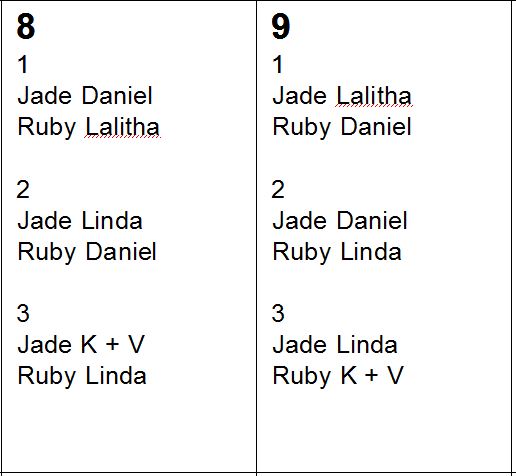
 Weekdays consisted of three class periods--8:30-10:30, 12:45-2:45, and 3:00-5:00, with lunch. It was a heavy schedule, but the weather was agreeable (not too hot, not too cool, and little rain), and the students were keen. After a long day, the ride home was a time to relax and unwind. Usually, rather than crossing the mountain, we asked Ashoka to take the river road, coasting without an engine two kilometers from the tunnel until the river came into view. From there, the road is perfectly flat, but it winds all along the river. On one trip, we jokingly suggested that Che's boys count the curves. They accepted the challenge and came up with 62! We often arrived home just as the sun was setting, the sky the most beautiful shade of sky-blue pink, and the birds preparing to roost.
Weekdays consisted of three class periods--8:30-10:30, 12:45-2:45, and 3:00-5:00, with lunch. It was a heavy schedule, but the weather was agreeable (not too hot, not too cool, and little rain), and the students were keen. After a long day, the ride home was a time to relax and unwind. Usually, rather than crossing the mountain, we asked Ashoka to take the river road, coasting without an engine two kilometers from the tunnel until the river came into view. From there, the road is perfectly flat, but it winds all along the river. On one trip, we jokingly suggested that Che's boys count the curves. They accepted the challenge and came up with 62! We often arrived home just as the sun was setting, the sky the most beautiful shade of sky-blue pink, and the birds preparing to roost.
The heart of the course was Merit, our Buddhist ESL textbook, which is set on a pilgrimage to the sacred sites in India. We're determined that this work in progress will be finished soon (or bust!). During the twenty days of class, some students covered sixteen lessons--a considerable achievement. Daniel and Linda were responsible for most of those lessons. It was our first chance to see other teachers use so much of the material, and we learned a lot from observing how they adapted it. On the evaluations, the students overwhelmingly expressed their approval of the book, which pleased us even more.
The two of us chose a Jataka story for each group. First, we read the story straight from Jataka Tales of the Buddha: An Anthology. Then we read it again in script form as a radio play. After practicing this several times, each student chose a role and spent time rehearsing those lines for the performance. On Monday of the final week, we recorded the two performances with sound effects. Everyone was pleased and rightly proud of their improvement, but one recording session was repeatedly interrupted by a particularly noisy train whistle from the station nearby.
|
Jataka Radio Play Recordings
|
||||||||
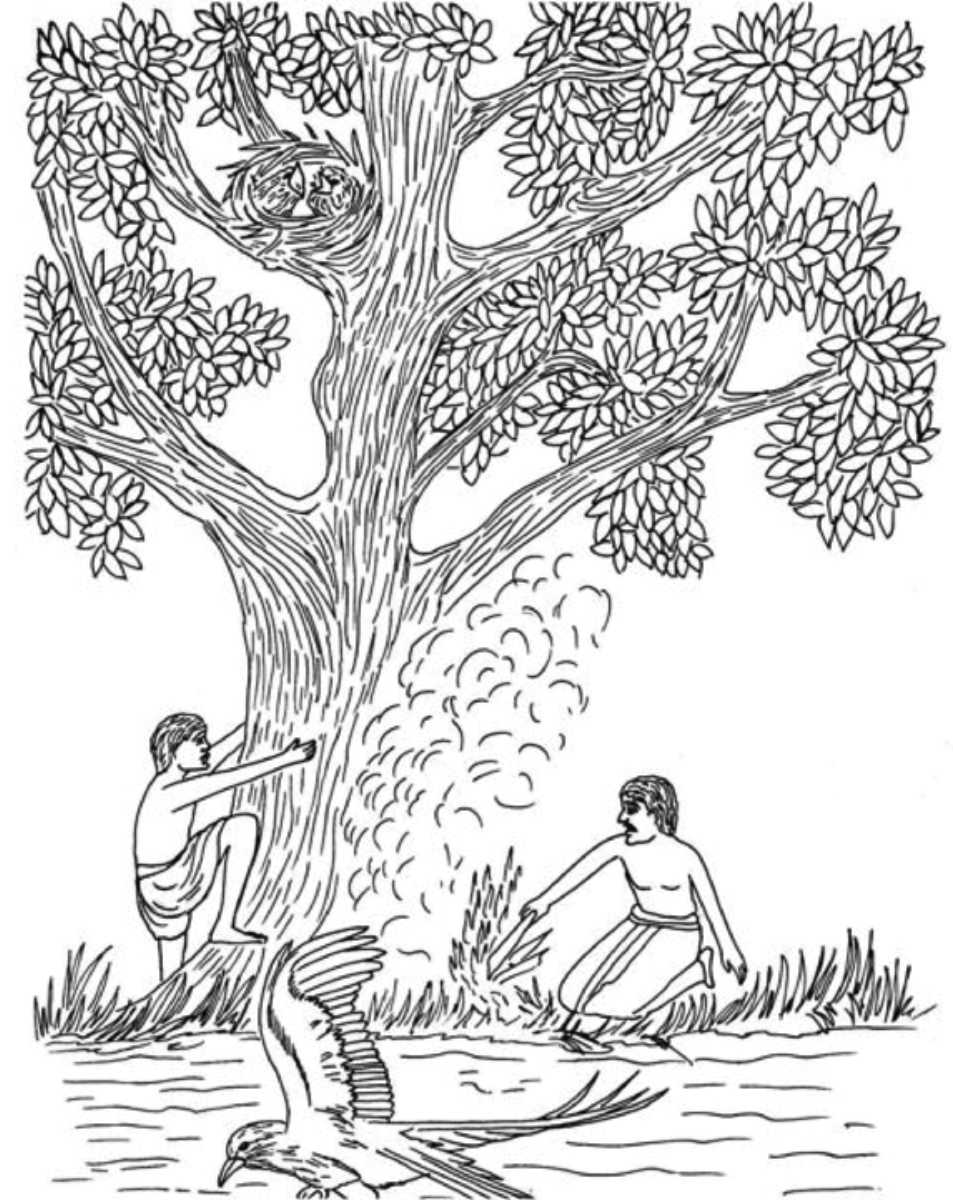 |
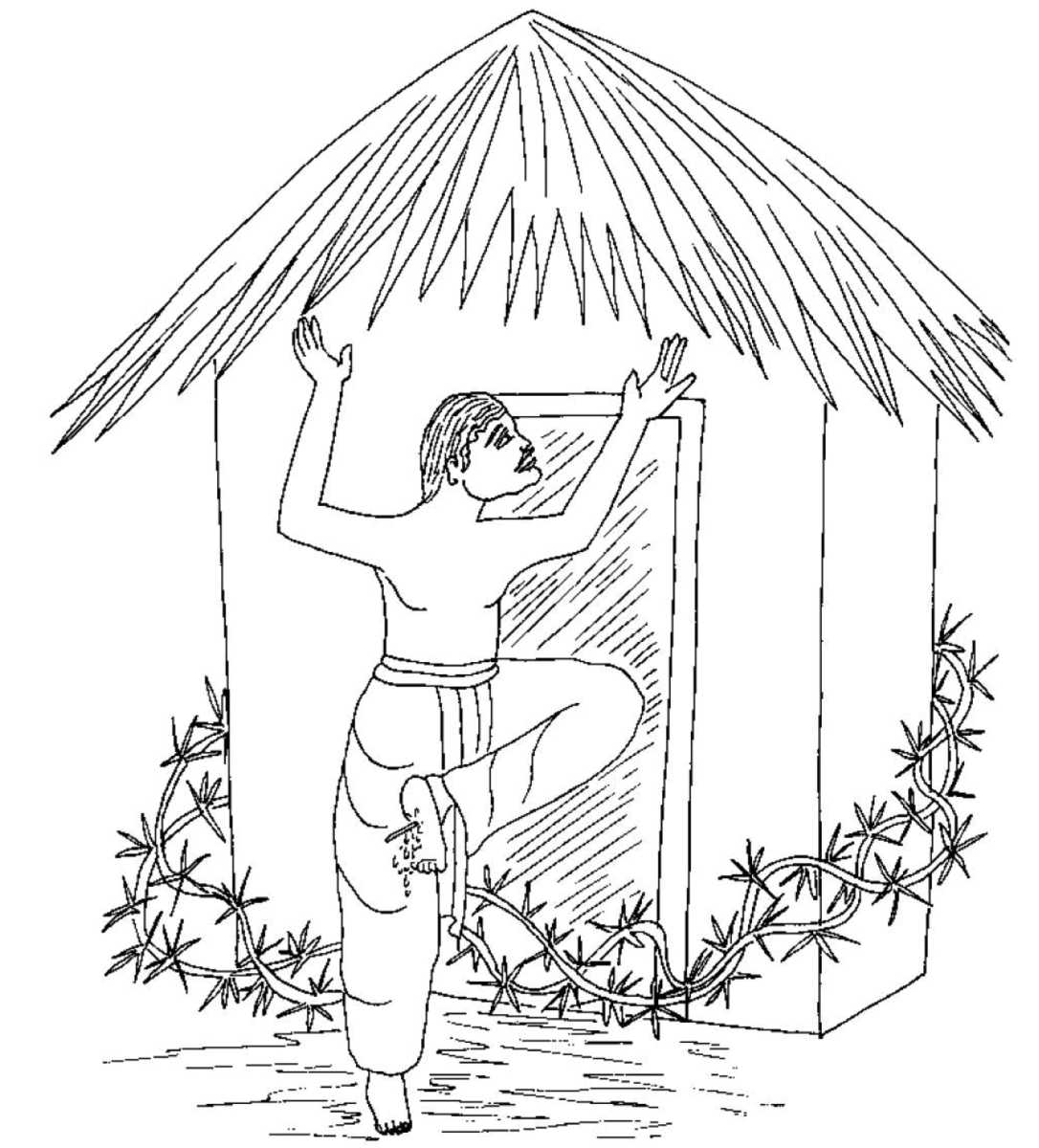 |
|||||||
|
Ruby Class
The Value of Friendship |
Jade Class
It's All the King's Fault |
|||||||
|
Click an illustration to hear the recording.
|
||||||||
We also used our Buddhist Wordsearch Puzzle to introduce and familiarize the students with basic Buddhist vocabulary and the 10 Steps controlled composition material, which the students took to like ducks to water. Most of them spent their lunch periods writing an exercise, and some managed to do four a day. They appreciated seeing their progress clearly documented in their notebooks. Many are continuing via email. With the lessons still coming in from the students of previous courses, we are checking about thirty lessons every day. Some students have advanced to the more challenging 26 Steps.
By popular request, Lalitha taught grammar. She began by asking the students what they wanted to study. They answered frankly, and she tailored her lessons accordingly. Everyone was satisfied. In his own inimitable fashion, in four days, Lal gave one group sixteen hours of academic writing, which was very successful. Ven. Upatissa and two other monks--Ven. Chandima, a Sri Lankan from Galagedara and Ven. Vinita, a Czech staying at Kanduboda--gave each group two sessions on communicative skills, including active listening, and a taste of counseling. This was the students' first exposure to this field, and it was a valuable experience.
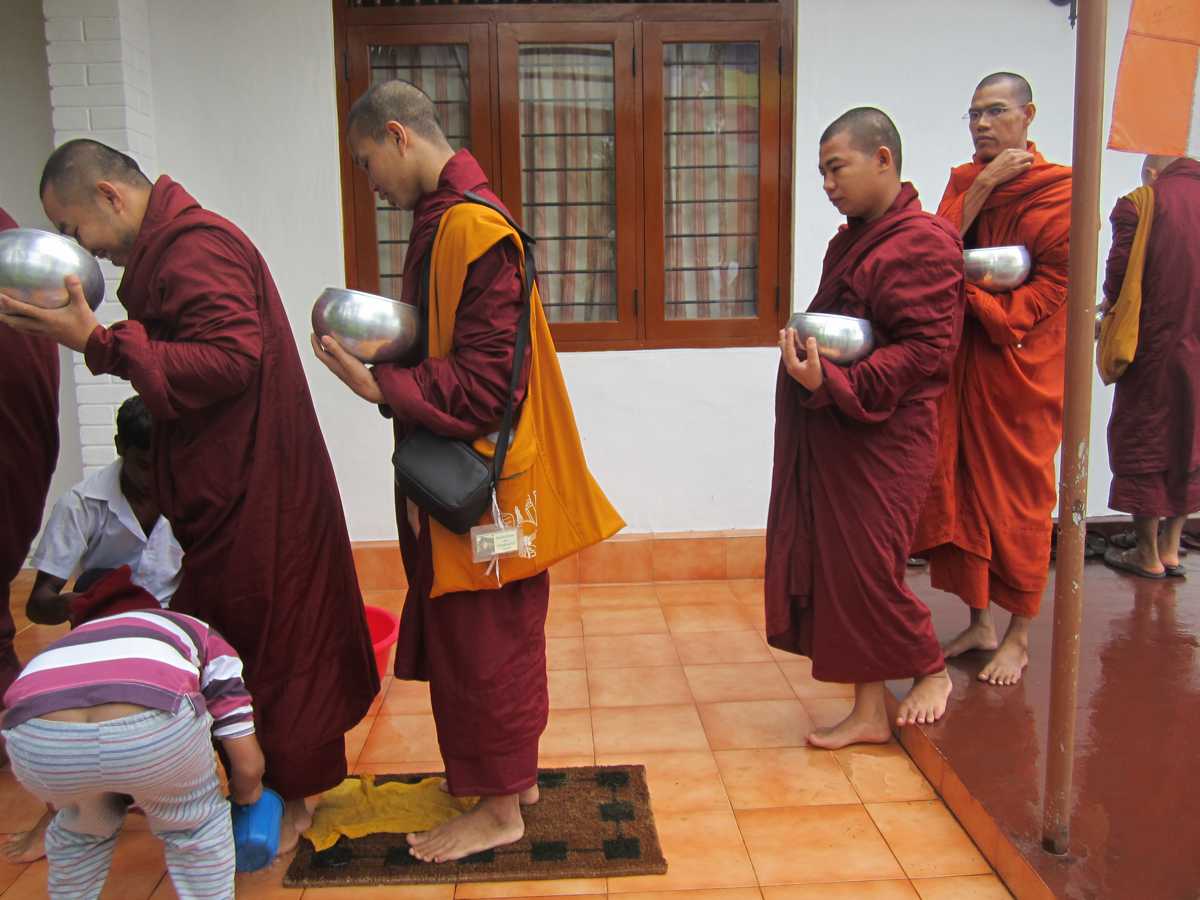 |
|
| Click this photo to see all the photos of that day | |
Instead of a "closing ceremony" at the end, we held an "appreciation ceremony" at the end of the third week. This was the last day for Linda and Daniel, and the first for Che. Mike, newly back from the States, was able to join, so everyone could hear the students' speeches, and give their own as well. Mike was the only attendee who could speak both English and Sinhala, so he was called upon to translate Ven. Upali's speech, and he did himself proud!
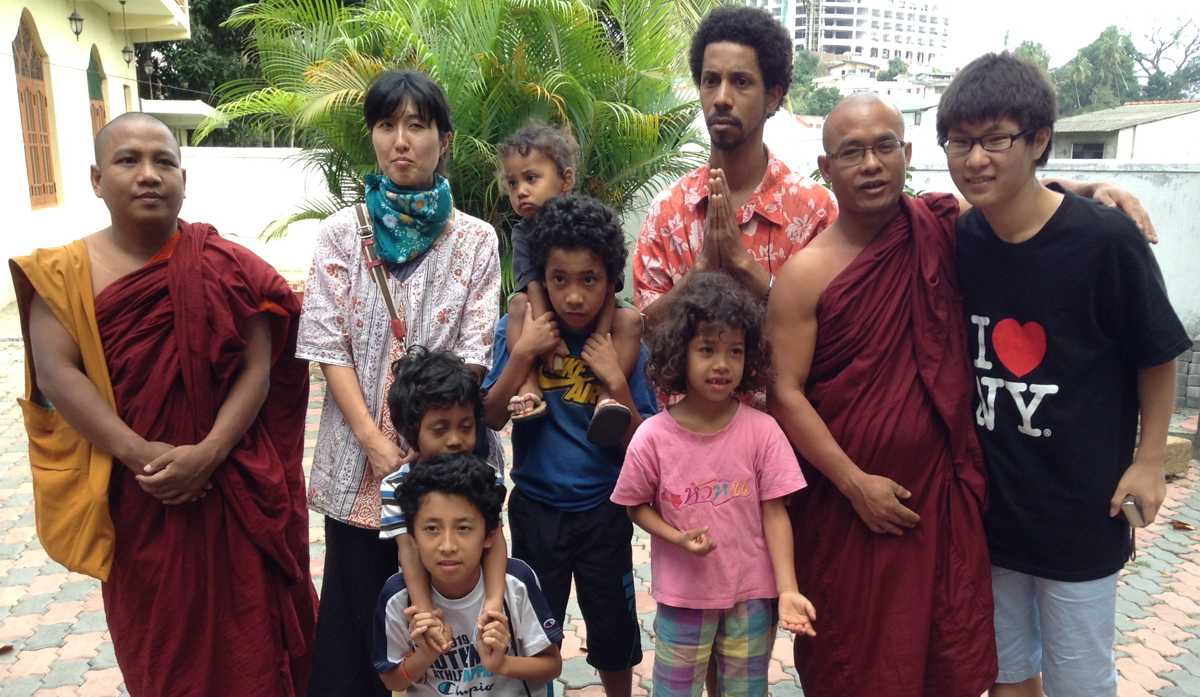
 |
||
| View and download the poster 144KB 1030 x 1415 1MB 2473 x 3395 4MB 2473 x 3395 |
||
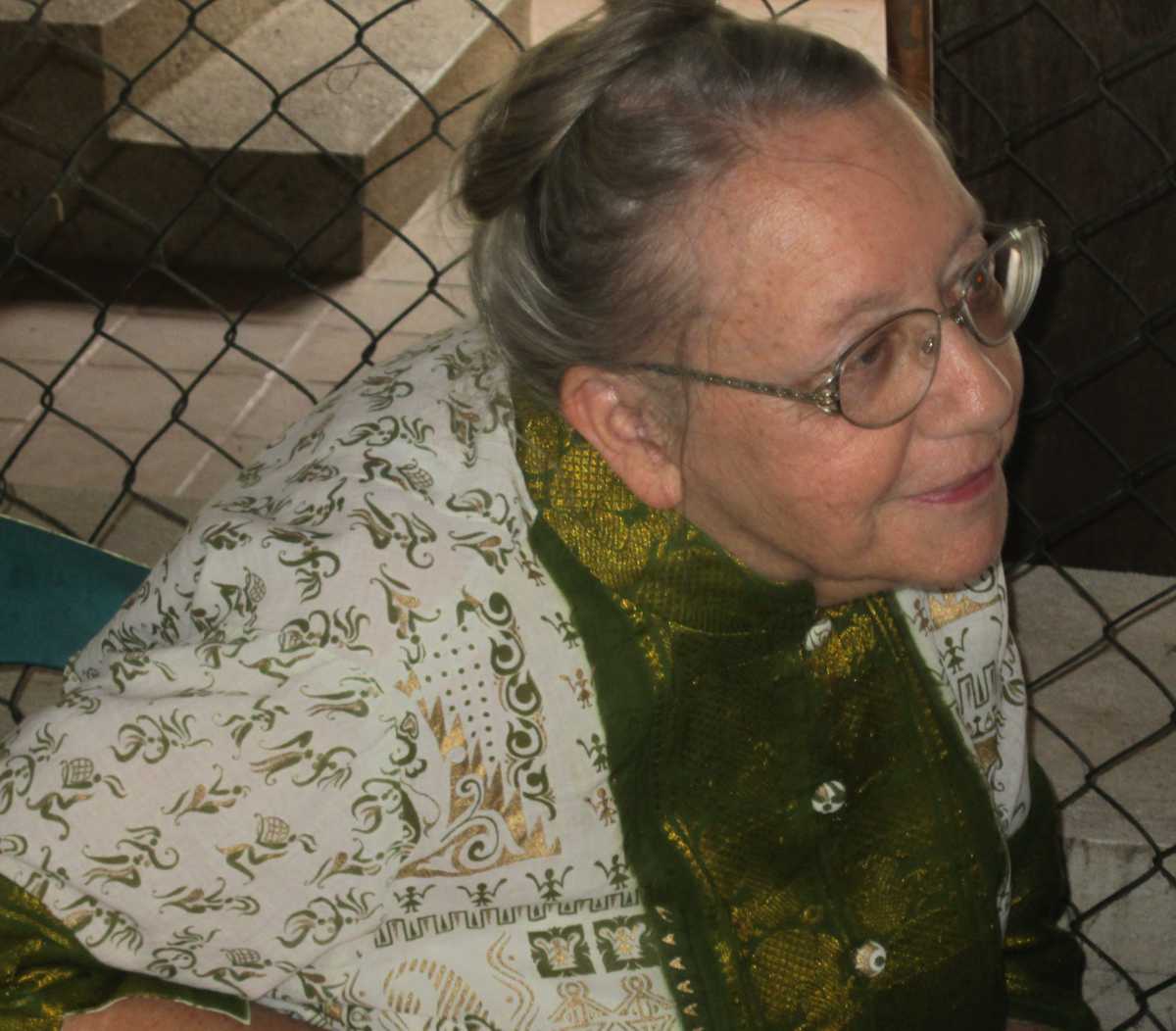 Out-of-class activities were a great part of what made the intensive course intense! Special events were planned for each Saturday and Sunday. These included visits to the Temple of the Tooth and its adjuncts around Kandy, a full afternoon at the International Buddhist Museum, and a bus trip to three outstanding temples near Kandy--Degodoruwa, Lankatilaka, and Gadaladeniya. For each of these activities we had developed a worksheet to encourage the students to work in groups to understand and record what they were seeing. Our friend Julia graciously lent us her 40-inch TV so that we could show two movies. The students cheerfully sat on mats in the living room to watch Miyazaki's "Princess Mononoke" and Disney's "Beauty and the Beast," both of which stimulated a lot of discussion. During intermissions, we offered the students juice and the catumadhu which Lal and Linda had patiently stirred for hours.
Out-of-class activities were a great part of what made the intensive course intense! Special events were planned for each Saturday and Sunday. These included visits to the Temple of the Tooth and its adjuncts around Kandy, a full afternoon at the International Buddhist Museum, and a bus trip to three outstanding temples near Kandy--Degodoruwa, Lankatilaka, and Gadaladeniya. For each of these activities we had developed a worksheet to encourage the students to work in groups to understand and record what they were seeing. Our friend Julia graciously lent us her 40-inch TV so that we could show two movies. The students cheerfully sat on mats in the living room to watch Miyazaki's "Princess Mononoke" and Disney's "Beauty and the Beast," both of which stimulated a lot of discussion. During intermissions, we offered the students juice and the catumadhu which Lal and Linda had patiently stirred for hours.
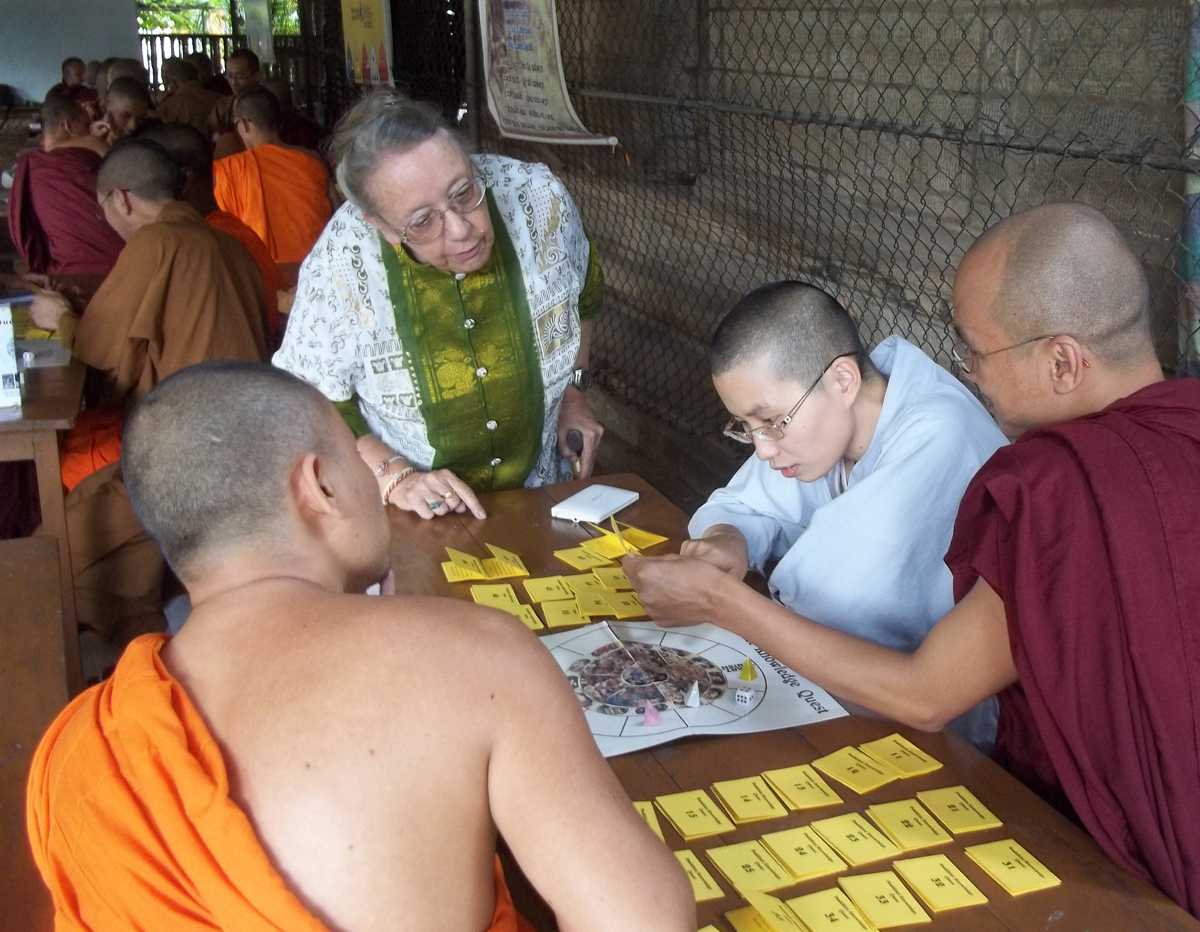 |
|||
| Click the photo to see more photos of Buddhist Knowledge Quest | |||
 We arranged all the prizes, more than 70 Dhamma books, all the sets of BKQ we'd used during the course, and some nifty airline travel kits Linda had collected, on tables at the back of the big room. After lunch, the grand winner of Buddhist Knowledge Quest--all four levels--got his first choice, followed by the second tier of winners, and the third. By the time the table was cleared, everyone who'd played received something.
We arranged all the prizes, more than 70 Dhamma books, all the sets of BKQ we'd used during the course, and some nifty airline travel kits Linda had collected, on tables at the back of the big room. After lunch, the grand winner of Buddhist Knowledge Quest--all four levels--got his first choice, followed by the second tier of winners, and the third. By the time the table was cleared, everyone who'd played received something.
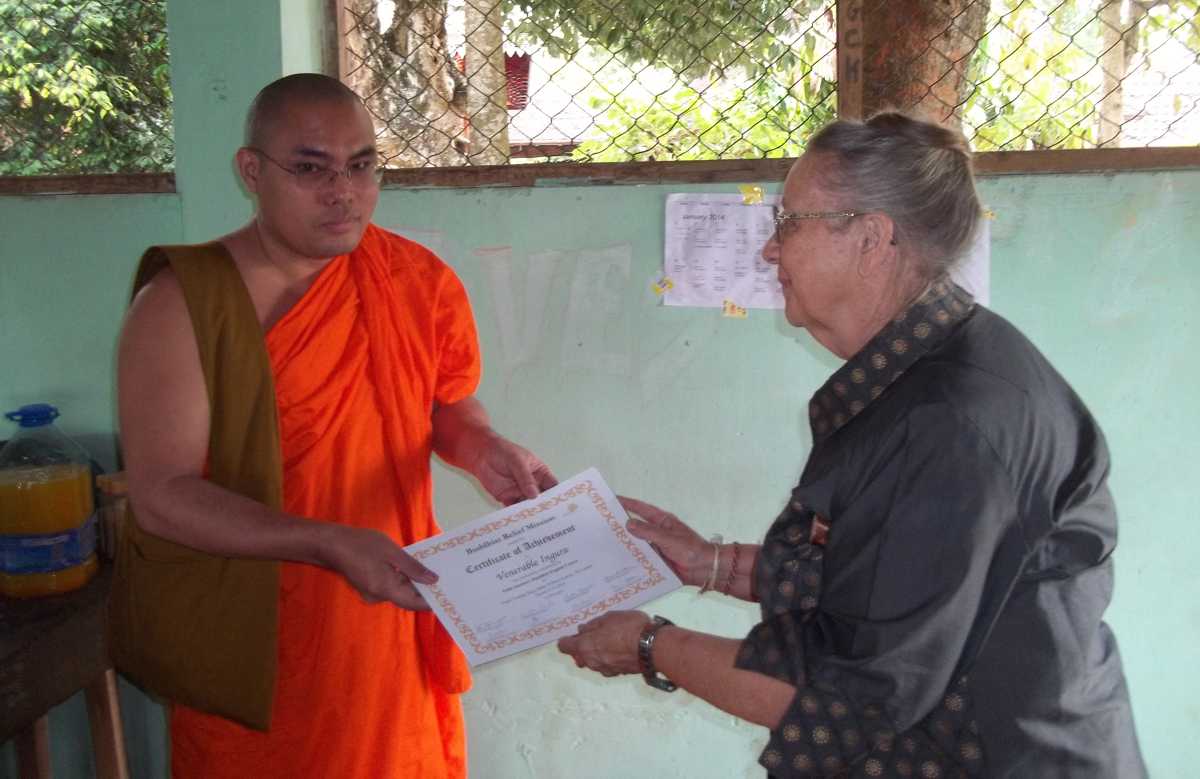
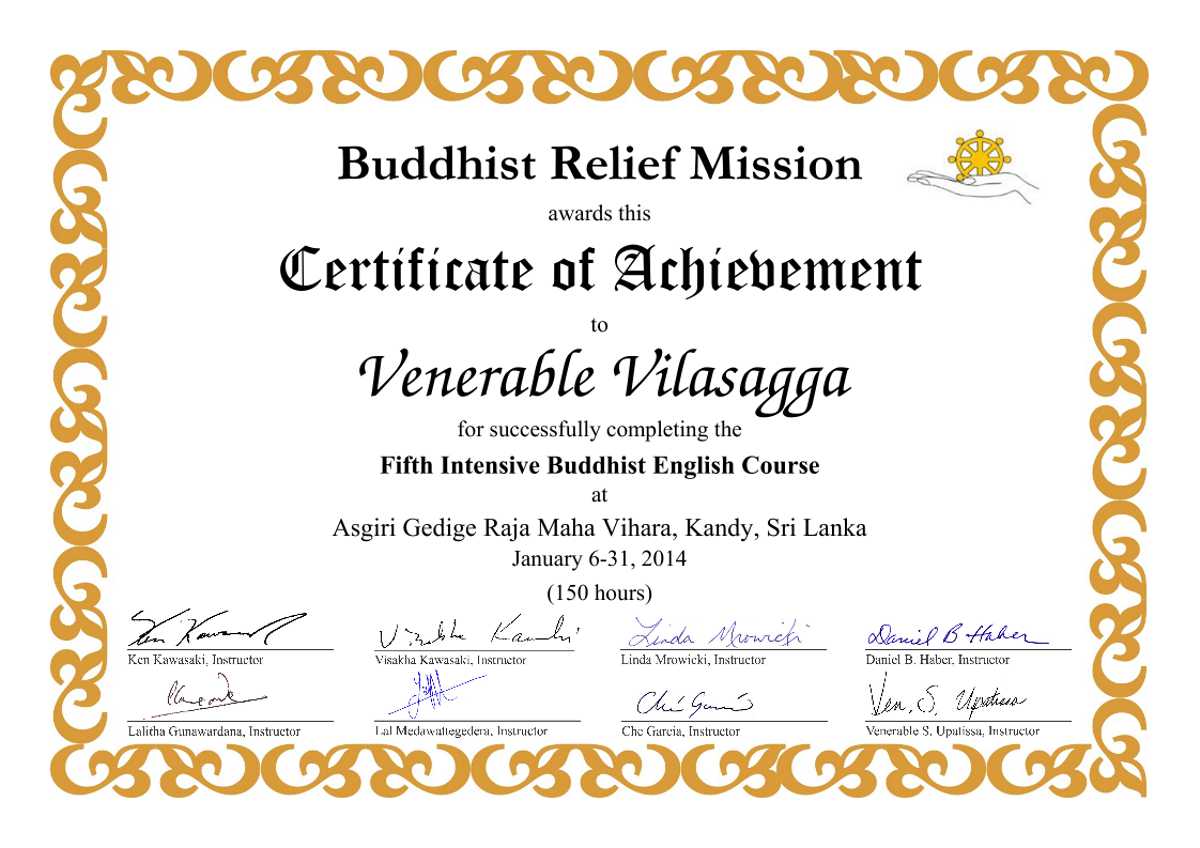 Finally, to the clicking of many cameras, we handed out a Certificate of Achievement to each student who had completed the course. After thanks and congratulations all around, we ended early enough to allow the Burmese monks to return to the Burmese Rest to clean their rooms and to get back to Colombo before dark. All of us were a little exhausted from the effort we had been putting out for so long, but we also felt exhilarated. Looking over the course evaluations afterwards, we found the students articulating their sense of accomplishment, their increased self-confidence, their appreciation for material mastered, the strengths they had discovered, and the friendships they had made. That's quite a reward.
Finally, to the clicking of many cameras, we handed out a Certificate of Achievement to each student who had completed the course. After thanks and congratulations all around, we ended early enough to allow the Burmese monks to return to the Burmese Rest to clean their rooms and to get back to Colombo before dark. All of us were a little exhausted from the effort we had been putting out for so long, but we also felt exhilarated. Looking over the course evaluations afterwards, we found the students articulating their sense of accomplishment, their increased self-confidence, their appreciation for material mastered, the strengths they had discovered, and the friendships they had made. That's quite a reward.
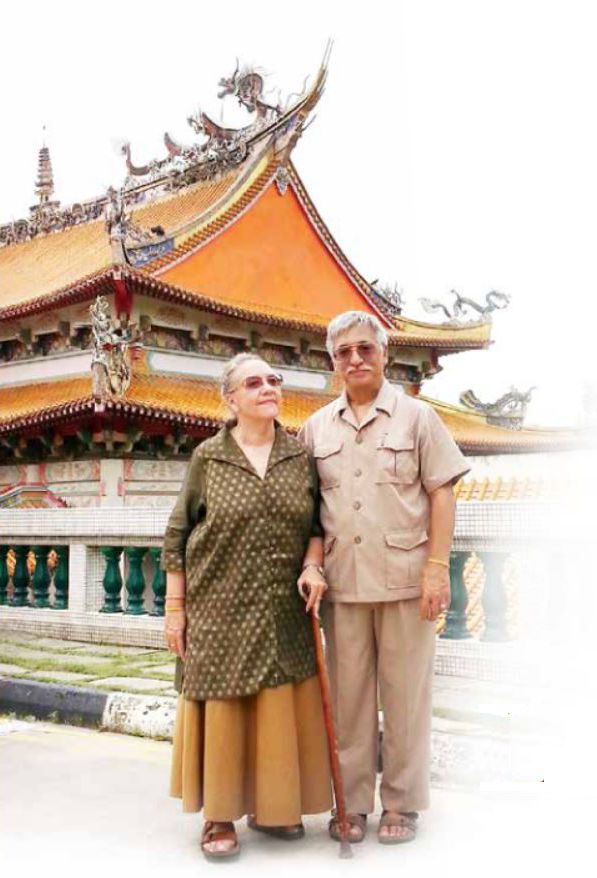 In our last report, we mentioned that we had been interviewed and photographed for an article in the magazie of Phor Kark See Monastery in Singapore. Here is that article. (Pages 10-13)
In our last report, we mentioned that we had been interviewed and photographed for an article in the magazie of Phor Kark See Monastery in Singapore. Here is that article. (Pages 10-13)
On January 1, most of the students from our class at Subodharama came for a New Year's Dana. Here are photos of that occasion.
On January 2, Ven. Amilasiri came from Kurunegala with a busload of novices who chanted paritta to bless our new home. Here are photos of that occasion.
Ven. S. Dhammika introduced us to a Vietnamese publisher who is going to translate Jataka Tales of the Buddha into Vietnamese and publish it for distribution in that country.
 Our bio-gas plant is working at last! Every other day or so, Lily is able to boil several large pots of water for drinking using our very own gas. Hooray!
Our bio-gas plant is working at last! Every other day or so, Lily is able to boil several large pots of water for drinking using our very own gas. Hooray!